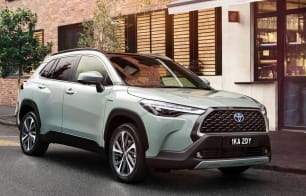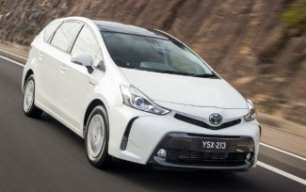We can talk about looks later, so let’s see much it costs to buy a Corolla Cross.
First thing to know is there are three grades in the Corolla Cross range.
The most affordable versions of the Corolla Cross are those with just the petrol engine, not the petrol-electric hybrid options further up the range. The non-hybrid GX lists at $33,000, the GXL is $36,750 and the top-of-the-range Atmos is $43,550.
It’s a good time to point out that if you want a Corolla Cross with a non-hybrid drivetrain then you’ll only be able to get it as a front-wheel drive, not all-wheel drive..
The hybrid variants are available in both front-wheel drive and all-wheel drive.
So the GX Hybrid front-wheel drive is $35,500. The GXL Hybrid is $39,250 for the front-wheel drive and $42,250 for the all-wheel drive. The Atmos Hybrid is $46,050 for the front-wheel drive and $49,050 for the all-wheel drive.
Got it? You may have noticed the GX Hybrid doesn’t come in all-wheel drive, so yes, you’ll have to step up to the GXL if you’d like it.
Do you need all-wheel drive? It’s not at all vital, but if you’re travelling regularly on gravel roads or snow then all-wheel drive tends to provide much better traction than front-wheel drive.
Coming standard on the GX are LED headlights and 17-inch alloy wheels, fabric seats, climate control, proximity keys, an 8.0-inch touch screen, Android Auto and wireless Apple CarPlay, a six-speaker stereo and digital radio, a reversing camera plus advanced safety tech covered in detail in the Safety section of this review.
The GXL gets all that and adds roof rails and rear privacy glass, leather upholstered seats and steering wheel, dual-zone climate control, a 10.5-inch display with built-in sat nav.
Now the Atmos, which sounds like a bathroom cleaner but it’s the very fanciest Corolla Cross with its panoramic moon roof and 18-inch alloys, a power tailgate and power driver's seat. Those front seats are heated, and so is the steering wheel. There's a 12.3-inch digital instrument cluster and wireless phone charging.
The Corolla Cross is well-priced compared to its rivals.The Haval Jolion has almost identical pricing across its range but the Corolla Cross goes one better for value by offering a hybrid variant in every grade, not just the top-of the-range as the Haval does. The Honda HR-V is another rival and while it's pricing is close to the Corolla Cross its two-grade line-up doesn't offer much choice.






